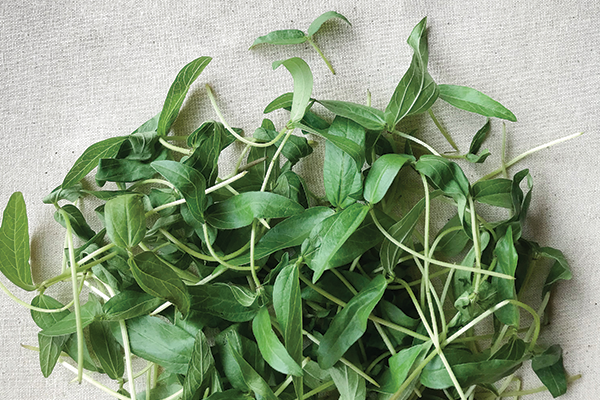What Are Microgreens?
Microgreens are young vegetable greens. Not to be confused with sprouts, which don’t have any leaves, these greens are ready to harvest after the first set of true leaves come in. Measuring at one to three inches, these tiny greens are packed with nutrients and offer various health benefits. Despite their miniature size, microgreens tend to host more of a nutritional punch than their more mature counterparts.
In addition to the health benefits, these aromatic baby plants pack flavor into meals. Microgreens come in multiple colors and flavors, offering numerous ways to incorporate them into your diet.
Nutrient Content
The nutrients in this superfood depend on the type of seed from which they’re grown. Most varieties are high in potassium, iron, zinc, magnesium, and copper. They’re also rich in antioxidants, specifically polyphenol. Polyphenols can help reduce the risk of several diseases. Here are some additional nutrients microgreens may provide:
- Potassium helps carry out a range of functions in the body. Nerve cells use potassium to communicate with each other. Potassium also helps muscles contract, including muscle cells in the heart. It’s essential for heart health.
- Iron helps fuel the body. It keeps energy levels up by improving circulation. The iron in blood cells helps carry oxygen throughout the body and to the brain. Oxygen keeps the brain alert and functioning well.
- Zinc, magnesium, and copper promote healthy bones and teeth. They’re also necessary for detoxification, regulating temperature, and transmission of nerve impulses.
Microgreens are an effective way to incorporate these nutrients into your diet. The superfood has nutrient levels that are up to nine times the levels found in mature greens.

Health Benefits
Microgreens contain a wealth of nutrients and antioxidants, making them very beneficial for your health. Proper nutrition helps the body function and reduces the risks of diseases. Here are some examples:
- Microgreens are high in antioxidants and may reduce the risk of developing Alzheimer’s disease.
- Antioxidant-rich fruits and vegetables (including microgreens) that are high in polyphenol may help reduce the risk of certain cancers.
- Diabetes prevents sugar from efficiently entering cells. Antioxidants can alleviate the stress that causes diabetes. In particular, Fenugreek microgreens appeared to improve cellular sugar intake by 25-44% in lab studies.
- The antioxidants in microgreens may also lower the risk of heart disease. In animal studies, microgreens correlated with decreased levels of bad cholesterol.
There are limited studies on specific trends of microgreens reducing the risk of disease. Therefore, additional human studies are needed to establish if some benefits are conclusive.
How to Eat
Microgreens are a breeze to add to your favorite meals. You can use these aromatic greens in many of the same ways you would other greens.
Here are some tasty ways to use microgreens:
- Microgreens are delicious on sandwiches and wraps. They add extra flavor and make a great addition to any other greens you add in there.
- Salads are a simple way to incorporate these healthy baby plants. Sprinkle them on top of your salads for extra taste.
- Blend them into your smoothies and juices to effortlessly boost the nutritional value.
In addition to their distinct flavor profiles, microgreens tend to grow with vibrant colors. Their beautiful shades make plates look as fantastic as they taste.
Grow Your Own
Growing microgreens is fun and easier than you’d expect. Since they’re baby plants, you can harvest them between 7-10 days after planting the seeds. They’re convenient to grow, as they need little equipment and space. Here’s how to raise your own:
- To grow your very own microgreens, you need quality seeds and proper lighting. Ideal lighting is available 12-16 hours a day. Natural or UV light will work too. Microgreens also require an appropriate growing medium, like a container filled with high-quality soil and compost. Single-use growing mats are also sold specifically for growing microgreens.
- Plant seeds in rich soil by sprinkling them evenly on the top layer. Lightly mist seeds daily and cover them with a plastic top to trap humidity. After the seeds germinate, usually after a couple of days, remove the plastic lid. Continue misting daily as the microgreens grow and change color.
- Microgreens should be ready to harvest after 7-10 days.
Growing your microgreens is convenient and cost-effective. The process also allows you always to have some on hand to incorporate into meals.
Different Types of Microgreens
This superfood comes in different flavors and colors depending on the type of seed from which they’re grown. The vegetables that the seeds come from alter the taste of the microgreens.
The following plant families are most commonly used to grow this superfood:
- Amaranthaceae; examples: Beets, spinach, and swiss chard
- Amaryllidaceae; examples: Onions, leeks, and garlic
- Apiaceae; examples: Celery, carrots, and fennel
- Asteraceae; examples: Endive, radicchio, and lettuce
- Brassicaceae; examples: Radish, arugula, and broccoli
- Cucurbitaceae; examples: Squash, melon, and cucumber
The greens grown from these vegetables have a strong flavor profile. Flavors depend on the type, but can be considered neutral, spicy, sour, or bitter.
Bottom Line
Microgreens are a phenomenal and tasty superfood. They’re simple to add to meals, and the benefits speak for themselves. Their growing period is brief, and they’re easy to grow at home by yourself. The various types of microgreens have a multitude of flavors that’ll make your recipes more flavorful and healthier.










